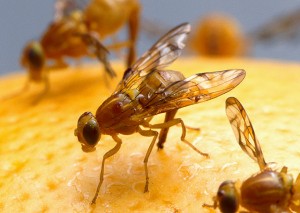THURSDAY, 9 DECEMBER 2010
A team of scientists from Tel Aviv University have conducted a series of experiments to investigate the mating preferences of fruit flies. A population of fruit flies was split in two and one group was fed on a diet of molasses, while the other was fed on starch. A generation later, the groups were re-integrated. The flies then showed a preference for mates with the same nutritional background, and this preference was maintained for at least thirty-seven generations. However, when an antibiotic was administered to the flies no such bias was evident. The preference only resumed when the intestinal bacterial species L. plantarum (known to be present in greater numbers in starch-fed flies than molasses-fed flies) was re-introduced into the flies that had been treated with the antibiotics.The fruit flies that underwent different dietary regimes also showed differences in their levels of sexual pheromones. These differences disappeared when antibiotics were administered. The findings of these experiments indicate that pheromone alterations are a mechanism by which mating preferences can be identified, and that bacteria could drive this change.
It has previously been thought that symbiotic partners evolve separately, but this new research supports a theory proposing that they together form a single basic unit in natural selection, known as a holobiont. Since a generation is much shorter for bacteria than for multi-cellular organisms, they are able to genetically adjust to environmental changes more rapidly. If this is the case, it would allow the evolution of multi-cellular organisms to occur on a much shorter timescale than previously imagined possible.
Written by Katy Wei

